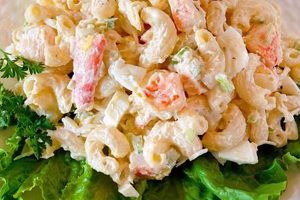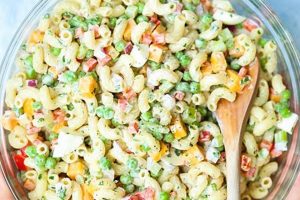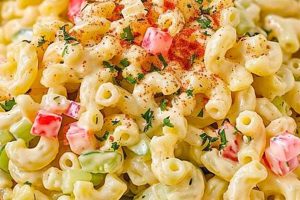A classic dish found at picnics, potlucks, and barbecues, this type of salad typically features cooked elbow macaroni, mayonnaise, celery, onion, and often hard-boiled eggs, sweet pickles, and mustard. Variations may include other vegetables like bell peppers or carrots, and seasonings such as paprika, garlic powder, or black pepper. A simple, creamy dressing binds the ingredients, creating a flavorful and satisfying side.
This dish’s popularity stems from its affordability, ease of preparation, and adaptability. The ingredients are readily available and relatively inexpensive. Its make-ahead nature makes it ideal for large gatherings, as it can be prepared a day or two in advance. Furthermore, the basic formula lends itself to customization, allowing for adjustments to ingredients and seasonings based on personal preference or dietary needs. Its presence at countless social gatherings speaks to its enduring appeal as a comfort food classic.
The following sections will delve into variations on the classic recipe, offering detailed instructions, tips for ingredient selection, and suggestions for presentation. Whether seeking a faithful recreation of a cherished family recipe or exploring new flavor combinations, readers will find ample inspiration and guidance.
Tips for a Perfect Macaroni Salad
Achieving optimal results requires attention to several key factors. The following tips offer guidance on ingredient selection, preparation methods, and storage techniques.
Tip 1: Cook the pasta al dente. Overcooked pasta will result in a mushy texture. Cook until firm to the bite, then rinse under cold water to stop the cooking process and maintain the desired texture.
Tip 2: Use high-quality mayonnaise. The mayonnaise serves as the base of the dressing and significantly impacts the overall flavor. Opting for a high-quality brand will elevate the taste and creaminess.
Tip 3: Add a touch of sweetness. A small amount of sugar or sweet pickle relish balances the savory elements and adds complexity to the flavor profile.
Tip 4: Don’t overmix. Gentle mixing ensures the ingredients are evenly distributed without breaking down the pasta or vegetables.
Tip 5: Chill thoroughly. Chilling allows the flavors to meld and enhances the overall taste. Refrigerate for at least two hours before serving.
Tip 6: Tailor the ingredients to preference. Experiment with different vegetables, seasonings, and add-ins to create unique variations. Consider adding chopped hard-boiled eggs, shredded carrots, or diced bell peppers.
Tip 7: Consider the addition of acid. A splash of vinegar or lemon juice brightens the flavors and adds a refreshing tang.
By following these guidelines, one can create a delicious and well-balanced dish that complements any meal. Attention to detail and careful selection of ingredients contribute to a superior culinary experience.
These tips provide a solid foundation for mastering this classic dish. The following section offers a collection of variations on the traditional recipe, catering to diverse palates and culinary preferences.
1. Elbow Macaroni
Elbow macaroni’s significance within traditional macaroni salad recipes stems from its shape and size. The curved tubes offer optimal surface area for capturing the creamy dressing, ensuring each bite delivers a balanced flavor profile. This shape also contributes to a pleasing texture, distinct from straight-cut pasta. Furthermore, the small size allows for easy incorporation with other ingredients, creating a cohesive mixture that holds its form well. Attempting to substitute elbow macaroni with significantly larger or differently shaped pasta alters the dish’s essential character. For instance, using long strands like spaghetti results in an unwieldy salad, difficult to serve and eat. Similarly, substituting small shapes like orzo diminishes the textural contrast, resulting in a denser, less appealing consistency. The choice of elbow macaroni, therefore, is a deliberate one, contributing significantly to the salad’s classic identity.
The practicality of elbow macaroni extends beyond its shape. Its widespread availability and affordability make it a convenient choice for large gatherings and budget-conscious cooks. Moreover, its quick cooking time simplifies the preparation process. This combination of practical and culinary advantages cements elbow macaroni’s integral role in the traditional macaroni salad recipe. Consider a church potluck or family barbecue: macaroni salad is a staple precisely because it is easy to transport, serve, and enjoy, largely due to the practicality of elbow macaroni.
In conclusion, the relationship between elbow macaroni and traditional macaroni salad recipes goes beyond mere ingredient inclusion. The pasta’s specific attributesits curved shape, small size, affordability, and availabilitycontribute fundamentally to the dish’s texture, flavor, and ease of preparation. Understanding this connection allows for informed ingredient selection, ensuring the resulting dish aligns with the classic expectations associated with a traditional macaroni salad. Deviations from this standard can lead to undesirable outcomes, highlighting the essential role elbow macaroni plays in this beloved dish.
2. Mayonnaise-based dressing
Mayonnaise-based dressing forms the heart of a traditional macaroni salad, contributing richness, creaminess, and a tangy flavor profile that defines the dish. This dressing acts as the unifying element, binding the various ingredientspasta, vegetables, seasoningsinto a cohesive whole. The emulsification within mayonnaise provides a smooth, coating texture that clings to the elbow macaroni, ensuring each bite delivers a balanced blend of flavors. Without this crucial component, the salad becomes a dry, disjointed collection of ingredients, lacking the characteristic richness and satisfying mouthfeel expected of a traditional preparation. Consider the difference between a well-executed macaroni salad and a simple pasta salad dressed with vinaigrette: the former offers a creamy, comforting experience, while the latter presents a lighter, more refreshing profile. This distinction underscores the essential role of mayonnaise in achieving the desired textural and flavor characteristics.
The importance of mayonnaise extends beyond its functional role as a binder. Its flavor profile, a blend of oil, egg yolks, and vinegar or lemon juice, adds a subtle tanginess that complements the other ingredients. This tanginess balances the sweetness often introduced through sweet pickle relish or sugar, creating a complex flavor dynamic. Furthermore, mayonnaise contributes a richness that enhances the overall sensory experience, making the salad more satisfying and palatable. Imagine a macaroni salad made with a low-fat or non-fat mayonnaise substitute: the resulting dish often lacks the characteristic creaminess and depth of flavor associated with the traditional version. This illustrates how the specific qualities of full-fat mayonnaise contribute significantly to the dish’s overall appeal.
In conclusion, mayonnaise-based dressing plays a critical role in defining a traditional macaroni salad. Its binding properties, textural contribution, and nuanced flavor profile are essential for achieving the desired outcome. Understanding the significance of this component allows for informed ingredient selection and preparation, ensuring the final product aligns with the classic expectations associated with this beloved dish. Attempts to substitute or omit the mayonnaise will inevitably result in a departure from tradition, potentially compromising the overall quality and enjoyment of the salad. This understanding reinforces the central role of mayonnaise-based dressing in the enduring appeal of traditional macaroni salad.
3. Chopped Vegetables
Chopped vegetables contribute essential textural and flavor dimensions to traditional macaroni salad, elevating it beyond a simple pasta and mayonnaise combination. These additions introduce complexity and balance, transforming the dish into a more dynamic and satisfying culinary experience. Understanding the role of these components is crucial for appreciating the nuanced character of this classic dish.
- Textural Contrast
Chopped vegetables, such as celery, onions, and bell peppers, introduce a crisp, refreshing counterpoint to the soft pasta and creamy dressing. This contrast prevents the salad from becoming monotonous, providing a more engaging mouthfeel. Imagine biting into a macaroni salad lacking any vegetable component: the texture would be uniformly soft, potentially leading to a less enjoyable experience. The addition of crisp vegetables provides a welcome textural variation.
- Flavor Complexity
Beyond texture, chopped vegetables contribute a depth of flavor that complements the richness of the mayonnaise and the subtle tang of mustard or vinegar. Celery offers a slightly bitter, herbaceous note, while onions provide a pungent sharpness. Sweet pickles or relish introduce a touch of sweetness, further enhancing the complexity of the overall flavor profile. A macaroni salad made solely with pasta and mayonnaise would lack this intricate interplay of flavors.
- Nutritional Value
The inclusion of chopped vegetables elevates the nutritional value of macaroni salad. These additions introduce vitamins, minerals, and dietary fiber, transforming a calorie-dense dish into a more balanced and wholesome option. While not a primary focus of the dish, this nutritional boost adds another layer of value to its inclusion in meals.
- Visual Appeal
The vibrant colors of chopped vegetables, particularly red onion, green bell peppers, or pimentos, enhance the visual appeal of the salad. This visual interest makes the dish more inviting and appetizing, further contributing to its overall appeal. A monochromatic macaroni salad, lacking the vibrant hues of vegetables, would appear less appealing, potentially diminishing the dining experience.
In summary, chopped vegetables are integral to the success of a traditional macaroni salad recipe. Their contribution extends beyond mere additions, fundamentally shaping the dish’s texture, flavor, nutritional value, and visual appeal. By understanding the multifaceted role of these components, one gains a deeper appreciation for the carefully balanced composition of this classic dish. Omitting or substituting these elements invariably alters the traditional character, highlighting their significance in defining a truly authentic macaroni salad experience.
4. Simple Seasonings
Simple seasonings play a crucial role in traditional macaroni salad recipes, providing subtle enhancements that elevate the overall flavor profile without overpowering the other components. This judicious use of seasonings distinguishes the dish from more complex salads, emphasizing the fresh, clean flavors of the primary ingredients. The delicate balance achieved through simple seasonings allows the inherent qualities of the macaroni, vegetables, and mayonnaise-based dressing to shine through. Overly assertive or complex spice blends can mask these subtle flavors, disrupting the harmonious balance characteristic of a traditional preparation. Consider the impact of adding a strong curry powder or a heavy dose of chili flakes to a macaroni salad: these additions would dominate the flavor profile, obscuring the delicate interplay of the core ingredients. This underscores the importance of restraint and careful selection when seasoning a traditional macaroni salad.
Common seasonings found in traditional macaroni salad recipes include salt, black pepper, and mustard. Salt enhances the overall flavor, bringing out the natural sweetness of the vegetables and the richness of the mayonnaise. Black pepper adds a subtle bite, providing a gentle counterpoint to the creamy texture. Mustard, often in the form of yellow mustard or dry mustard powder, contributes a tangy complexity that complements the other seasonings. These simple additions work synergistically, creating a balanced flavor profile that enhances, rather than overwhelms, the other ingredients. A sprinkle of paprika or a pinch of garlic powder may also be included, but these additions are typically used sparingly to avoid dominating the flavor profile. Practical examples of this balanced approach can be observed in countless family recipes and classic cookbook preparations, where the emphasis remains on the fresh, simple flavors of the core ingredients.
Understanding the role of simple seasonings in traditional macaroni salad recipes allows for a more nuanced approach to preparation. This knowledge empowers cooks to achieve a harmonious balance of flavors, highlighting the inherent qualities of the dish rather than masking them with overpowering seasonings. The delicate interplay of salt, pepper, and mustard underscores the importance of restraint in achieving a truly authentic and satisfying culinary experience. Deviation from this principle can lead to an unbalanced flavor profile, detracting from the classic character of the dish. Therefore, appreciating the significance of simple seasonings is essential for preserving the integrity and enduring appeal of traditional macaroni salad.
5. Cold Served
Serving macaroni salad cold is a defining characteristic, deeply intertwined with its traditional recipe and overall culinary experience. Temperature significantly influences flavor perception and textural appreciation. A chilled temperature accentuates the creamy richness of the mayonnaise-based dressing, while simultaneously enhancing the refreshing crispness of the chopped vegetables. This interplay of contrasting temperatures and textures is central to the dish’s appeal. Serving the salad warm, conversely, would diminish the mayonnaise’s richness, rendering it oily, and soften the vegetables, compromising their textural contribution. Consider a summer picnic or barbecue: a cold macaroni salad offers a refreshing counterpoint to grilled meats and other warm dishes, whereas a warm version would feel heavy and less appealing in such a context. This temperature-driven distinction underscores the fundamental connection between “cold served” and the traditional understanding of macaroni salad.
Practical considerations further reinforce the importance of serving macaroni salad cold. Food safety guidelines recommend maintaining cold temperatures for mayonnaise-based dishes to minimize bacterial growth. Serving the salad chilled ensures not only optimal flavor and texture but also safe consumption, particularly crucial during outdoor gatherings and potlucks where temperature control can be challenging. Furthermore, chilling allows the flavors to meld and deepen over time. Making macaroni salad ahead of time and allowing it to chill in the refrigerator enhances the overall taste experience, as the ingredients harmonize and the flavors intensify. This practical advantage aligns with the dish’s frequent presence at events where make-ahead preparations are valued. The ability to prepare and chill the salad in advance underscores the practical significance of “cold served” within the traditional macaroni salad context.
In conclusion, the “cold served” aspect of traditional macaroni salad recipes is not merely a serving suggestion but a crucial element that fundamentally shapes the dish’s character. The interplay of temperature and texture, along with food safety considerations and flavor development, highlight the integral role of chilling in achieving the desired culinary outcome. Attempting to deviate from this established practice compromises the dish’s defining qualities, underscoring the essential connection between “cold served” and the traditional understanding of macaroni salad. This understanding emphasizes the importance of adhering to this principle to preserve the dish’s integrity and ensure a satisfying culinary experience.
Frequently Asked Questions
This section addresses common inquiries regarding traditional macaroni salad recipes, providing concise and informative responses to clarify potential uncertainties and enhance understanding.
Question 1: Can alternative pasta shapes be used in traditional macaroni salad?
While other pasta shapes can be substituted, elbow macaroni is traditionally preferred due to its size and shape, which hold the dressing well and contribute to the classic texture. Substituting significantly larger or smaller shapes will alter the dish’s characteristics.
Question 2: How long can macaroni salad be stored in the refrigerator?
Properly stored in an airtight container, macaroni salad can typically be refrigerated for three to five days. Monitor for any signs of spoilage before consuming.
Question 3: Can traditional macaroni salad be frozen?
Freezing is not recommended. Mayonnaise-based dressings tend to separate upon thawing, resulting in an undesirable texture. The vegetables can also become mushy after freezing.
Question 4: What are common variations on traditional macaroni salad recipes?
Variations often involve incorporating different vegetables, such as bell peppers, shredded carrots, or peas. Additions like hard-boiled eggs, bacon, or tuna can also create unique flavor profiles. Some recipes include different seasonings like celery seed, paprika, or onion powder.
Question 5: How can one prevent macaroni salad from becoming watery?
Ensure the pasta is cooked al dente and well-drained. Avoid overmixing the salad, as this can release excess moisture from the vegetables. Adding the dressing shortly before serving can also minimize wateriness.
Question 6: What are suitable accompaniments for traditional macaroni salad?
This versatile side dish complements a wide range of main courses. It pairs well with grilled meats, fried chicken, sandwiches, and barbecue fare. It is also a frequent addition to picnic spreads and potluck meals.
Addressing these common queries provides a more comprehensive understanding of traditional macaroni salad recipes, enabling informed preparation and enjoyment of this classic dish.
The following section offers a collection of curated recipes showcasing diverse variations on the traditional theme.
Traditional Macaroni Salad Recipe
Exploration of the traditional macaroni salad recipe reveals a dish defined by simplicity, adaptability, and enduring appeal. Key elements, including elbow macaroni, mayonnaise-based dressing, chopped vegetables, simple seasonings, and a chilled serving temperature, contribute synergistically to its characteristic flavor and textural profile. Understanding the significance of each component allows for informed preparation and appreciation of this classic dish’s nuanced character. Variations, while permissible, should be approached with an awareness of how deviations might impact the traditional experience. From ingredient selection to preparation techniques, adherence to established principles ensures a result aligned with the dish’s intended identity.
The continued presence of traditional macaroni salad at countless gatherings underscores its enduring relevance within culinary traditions. This classic dish offers not only a satisfying culinary experience but also a connection to shared cultural heritage. Preserving the integrity of traditional recipes ensures the continuation of culinary practices that have shaped generations. Further exploration and appreciation of these culinary traditions enrich understanding of cultural history and promote the transmission of valuable culinary knowledge.






